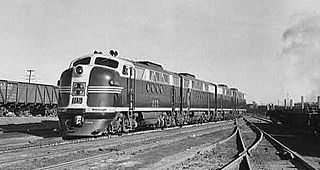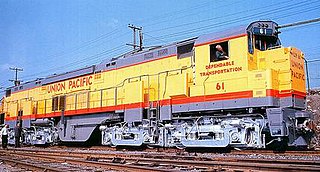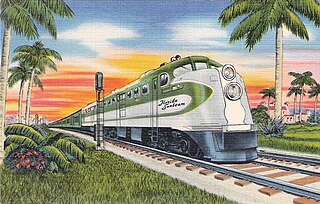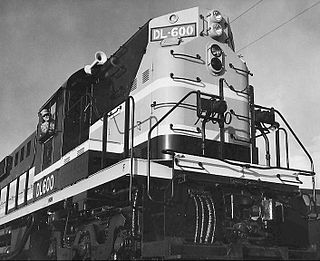Related Research Articles

The American Locomotive Company was an American manufacturer that operated from 1901 to 1969, initially specializing in the production of locomotives but later diversifying and fabricating at various times diesel generators, automobiles, steel, tanks, munitions, oil-production equipment, as well as heat exchangers for nuclear power plants.

The ALCO Century Series locomotives were a line of road switcher locomotives produced by Alco, the Montreal Locomotive Works and AE Goodwin under license in Australia.

Montreal Locomotive Works (MLW) was a Canadian railway locomotive manufacturer that existed under several names from 1883 to 1985, producing both steam and diesel locomotives. For many years it was a subsidiary of the American Locomotive Company. MLW's headquarters and manufacturing facilities were in Montreal, Quebec.

The EMD FT is a 1,350-horsepower (1,010 kW) diesel-electric locomotive that was produced between March 1939 and November 1945, by General Motors' Electro-Motive Corporation (EMC), later known as GM Electro-Motive Division (EMD). The "F" stood for Fourteen Hundred (1400) horsepower and the "T" for Twin, as it came standard in a two-unit set. The design was developed from the TA model built for the C,RI&P in 1937, and was similar in cylinder count, axle count, length, and layout. All told 555 cab-equipped ”A” units were built, along with 541 cabless booster or ”B” units, for a grand total of 1,096 units. The locomotives were all sold to customers in the United States. It was the first model in EMD's very successful F-unit series of cab unit freight diesels and was the locomotive that convinced many U.S. railroads that the diesel-electric freight locomotive was the future. Many rail historians consider the FT one of the most important locomotive models of all time.

The ALCO Century 855 was a model of 5,500 hp (4,101 kW) diesel-electric locomotive built in 1964 by the American Locomotive Company for the Union Pacific. The locomotive was notable for being ALCO's most powerful diesel-electric locomotive and, at the time, the most powerful diesel locomotive ever built, being surpassed by the 6,600-horsepower (4,922-kilowatt) EMD DDA40X in April 1969.

The ALCO PA was a family of A1A-A1A diesel locomotives built to haul passenger trains. The locomotives were built in Schenectady, New York, in the United States, by a partnership of the American Locomotive Company (ALCO) and General Electric (GE) between June, 1946 and December, 1953. Designed by General Electric's Ray Patten, they were of a cab unit design; both cab-equipped lead A unit PA and cabless booster B unit PB models were built. While externally the PB models were slightly shorter than the PA model, they shared many of the same characteristics, both aesthetically and mechanically. However, they were not as reliable as EMD E-units.

Electro-Motive Diesel is a brand of diesel-electric locomotives, locomotive products and diesel engines for the rail industry. Formerly a division of General Motors, EMD has been owned by Progress Rail since 2010. Electro-Motive Diesel traces its roots to the Electro-Motive Engineering Corporation, founded in 1922 and purchased by General Motors in 1930. After purchase by GM, the company was known as GM's Electro-Motive Division. In 2005, GM sold EMD to Greenbriar Equity Group and Berkshire Partners, and in 2010, EMD was sold to Progress Rail. Upon the 2005 sale, the company was renamed to Electro-Motive Diesel.

The ALCO RS-2 is a 1,500–1,600 horsepower (1,100–1,200 kW) B-B diesel-electric locomotive built by the American Locomotive Company (ALCO) from 1946 to 1950. ALCO introduced the model after World War II as an improvement on the ALCO RS-1. Between 1946 and 1950, 377 examples of the RS-2 were built, primarily for American and Canadian customers.

The ALCO DL-109 was one of six models of A1A-A1A diesel locomotives built to haul passenger trains by the American Locomotive Company (ALCO) between December, 1939 and April, 1945. They were of a cab unit design, and both cab-equipped lead A units DL-103b, DL-105, DL-107, DL-109 and cabless booster B units DL-108, DL-110 models were built. The units were styled by noted industrial designer Otto Kuhler, who incorporated into his characteristic cab the trademark three-piece windshield design. A total of 74 cab units and four cabless booster units were built.

The ALCO RSD-7 was a diesel-electric locomotive of the road switcher type built by ALCO at Schenectady, New York between January 1954 and April 1956. Two versions were built, with the same RSD-7 model designation but different specifications and power ratings, although both used the ALCO 244 engine in V16 configuration. Specification DL-600, of which only two were built, developed 2,250 hp and used the 244G engine. The revised specification DL-600A, numbering 27 locomotives, was rated at 2,400 hp and used the 244H engine. The RSD-7 was superseded by the ALCO 251-engined ALCO RSD-15, which looks very similar. The RSD-7 was the last ALCO diesel built with a 244 engine.
The Erie-built was the first streamlined, cab-equipped dual service diesel locomotive built by Fairbanks-Morse, introduced as direct competition to such models as the ALCO PA and FA and EMD FT. F-M lacked the space and staff to design and manufacture large road locomotives in their own plant at Beloit, Wisconsin, and was concerned that waiting to develop the necessary infrastructure would cause them to miss out on the market opportunity for large road locomotives. Engineering and assembly work was subcontracted out to General Electric, which produced the locomotives at its Erie, Pennsylvania, facility, thereby giving rise to the name "Erie-built."

The EMD 567 is a line of large medium-speed diesel engines built by General Motors' Electro-Motive Division. This engine, which succeeded Winton's 201A, was used in EMD's locomotives from 1938 until its replacement in 1966 by the EMD 645. It has a bore of 8+1⁄2 in (216 mm), a stroke of 10 in (254 mm) and a displacement of 567 cu in (9.29 L) per cylinder. Like the Winton 201A, the EMD 645 and the EMD 710, the EMD 567 is a two-stroke engine.

The ALCO FA was a family of B-B diesel locomotives designed to haul freight trains. The locomotives were built by a partnership of ALCO and General Electric in Schenectady, New York, between January 1946 and May 1959. Designed by General Electric's Ray Patten, they were of a cab unit design; both cab-equipped lead FA and cabless booster FB models were built. A dual passenger-freight version, the FPA/FPB, was also offered. It was equipped with a steam generator for heating passenger cars.
The ALCO DL-202-2 and DL-203-2 diesel-electric locomotive was an experimental freight locomotive produced by ALCO of Schenectady, New York. The primary diesel builders Alco, Baldwin and EMD pushed the War Production Board (WPB) for more opportunities to build more diesels. The Transportation Equipment Division of the WPB announced a production schedule on December 10, 1943, that allowed Alco to build one 4500 horsepower experimental diesel locomotive. This experimental diesel locomotive was to be built in the fourth quarter of 1944. The two A units were built in January 1945 and the B unit at a later date in 1945. The two A units were put on test at Building No. 37 at Schenectady to work out problems with the connecting rods and turbocharger in the Alco 241 engine, developed by both McIntosh and Seymour and ALCo. The total production run included 2 cab DL202-2 A units, and a single DL203-2 B unit. The locomotives were powered by a V12 ALCO 241 diesel engine, rated at 1,500 hp (1.1 MW). The units were released for test in September 1945. The locomotive could attain a top speed of 80 mph (130 km/h) (Freight) and 125 mph (201 km/h) (Passenger). With the B-B wheel arrangement and carbody construction, equipment layout and electrical gear these experimental units were the immediate predecessors of the FA units to come in early 1946. Outwardly, the bodies strongly resembled those on the DL-109, some of which were still under construction at Schenectady in early 1945.

The EMD 710 is a line of diesel engines built by Electro-Motive Diesel. The 710 series replaced the earlier EMD 645 series when the 645F series proved to be unreliable in the early 1980s 50-series locomotives which featured a maximum engine speed of 950 rpm. The EMD 710 is a relatively large medium-speed two-stroke diesel engine that has 710 cubic inches displacement per cylinder, and a maximum engine speed of 900 rpm.
The ALCO 251 is a 4-stroke diesel engine that was developed by the American Locomotive Company to replace its 244 and 539 engines. The 251 was developed to be used in diesel locomotives, as a marine power plant in ships, and as a stationary power generator.
The GE Universal Series is a series of diesel locomotives intended for the export market introduced by General Electric in early 1956. General Electric had previously partnered with Alco, producing locomotives for export using Alco's 244 engine, and provided electrical parts for Alco's domestic production. However, with the advent of the Universal Series, GE ended its partnership with Alco and entered the export locomotive market on its own.
Maine Central Railroad began operating diesel locomotives in 1935, and had retired all steam locomotives by 1954. That time interval was a joint operating period with the Boston and Maine Railroad (B&M). This article describes diesel locomotives owned by Maine Central through the period of joint operation and later independent operation prior to Guilford Rail System control in 1981.
The ALCO 244 was a diesel prime mover built by the American Locomotive Company (ALCO). An evolution of the earlier 241 diesel engine, it powered ALCO's first generation of production road locomotives. The 244 engine was developed to create an engine capable of being used in railroad freight and passenger locomotives. The 244 engine was also used in a very limited basis as a marine power plant in ships and as a stationary power generator.
References
Footnotes
Bibliography
- Steinbrenner, George (2003). The American Locomotive Company: A Centennial Remembrance. Warren, NJ: On Track Publishers, LLC. ISBN 0911122-07-9.
- Cuisinier, W. A. (Preston Cook) Extra 2200 South Issue #34 May June 1972 "Technifocus For The Technician Pre- FA (Black Maria) pp. 17–18.